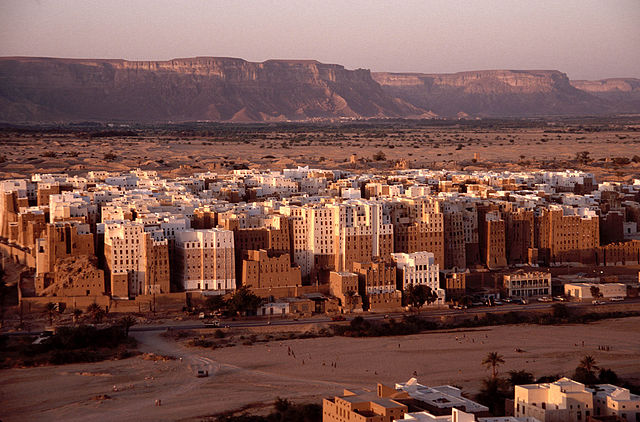Mudhattan

Pictured above is a city, which, except for the surroundings — empty plains followed by plateaus in the rear, a wide dirt expanse at the front — would appear to be like most other city. (Here’s a view from above.) But those oddities are only the beginning of what makes the above unique. First, there are about 500 skyscrapers (to use the term loosely) clustered in that area — a strange level of density given the emptiness surrounding the towers. Second, each tower is only between five and eleven stories high. Third, the entire city is only home to about 7,000 residents — that’s roughly one person per floor, give or take.
But the most surprising part about the city above?
It’s made of mud.
The city is called Shibam, located roughly in the center of the Yemen. (Here’s a map.) Shibam, albeit in earlier incarnations, has been around for over 1,700 years, and over its long history was a thoroughfare for the spice trade and other commerce in the region. The buildings above date back to about 1530 — they’re about 500 years old — and were built after a flood destroyed most of the buildings which were situated there prior, according to Atlas Obscura. Hoping to avoid a similar fate while also building a walled city which could prevent raids from Bedouins, the people of Shibam at the time constructed these tower houses — mixed-purpose buildings designed both as homes and as defensive stalwarts. And in doing so, they created what is widely considered to be one of the first examples of “urban planning based on the principles of vertical construction,” as described by UNESCO — one which has earned the nickname “the Manhattan of the desert.”
The buildings aren’t as resilient as they look, though. The elements — particularly the winds and occasional rains — wear the buildings away over time, requiring new layers of mud to be applied at least every few years.
More photos of Shibam are available here.
Bonus Fact: Epcot Center, the theme park at Walt Disney World in Florida, wasn’t supposed to be a theme park at all. Originally, Walt Disney (the man, not the company) developed it to be his foray into urban planning — EPCOT was an acronym for “Experimental Prototype Community of Tomorrow.” Most of Mr. Disney’s plans for Epcot were abandoned after his death in 1966, but if you’ve ever wondered why Disney World has monorails, this is a large reason why.
From the Archives: The Land of Dragon’s Blood and Elephant Plants: An island off of Yemen’s coast which is home to plants seen nowhere else.
Related: “Yemen: The Unknown Arabia” by Tim Mackintosh-Smith. Four stars on eight reviews.
